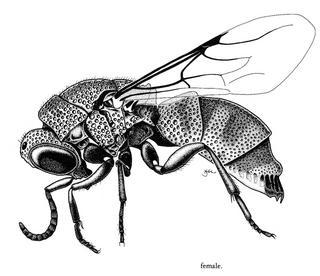
L. S. Kimsey and R. M. Bohart, 1990 · 9
Ipsiura neolateralis |
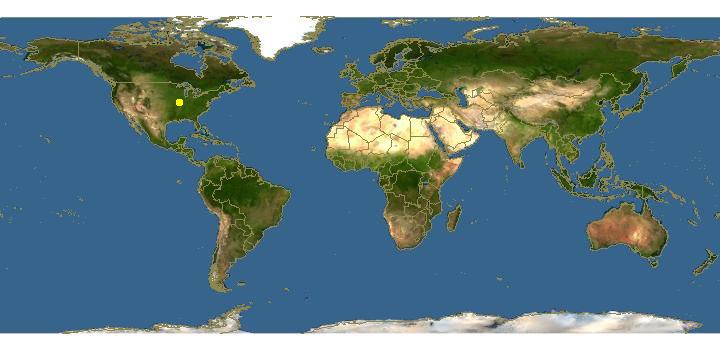
Click on map for details about points.
|
80x5 -
240x3 -
240x4 -
320x1 -
320x2 -
320x3 -
640x1 -
640x2
Set display option above.
Click on
images to enlarge. |
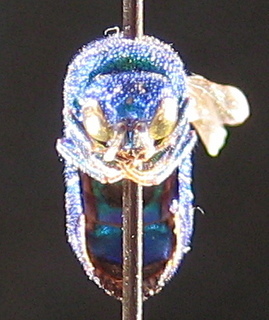
Native Bee Inventory and Monitoring Lab; Photographer: Josh · 9
Ipsiura neolateralis, face |
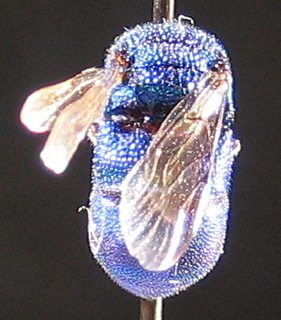
Native Bee Inventory and Monitoring Lab; Photographer: Josh · 9
Ipsiura neolateralis, tail |
|
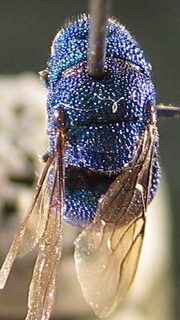
Native Bee Inventory and Monitoring Lab; Photographer: Josh · 9
Ipsiura neolateralis, top |
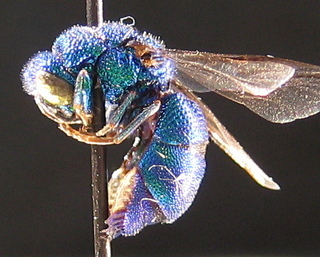
Native Bee Inventory and Monitoring Lab; Photographer: Josh · 9
Ipsiura neolateralis |
|
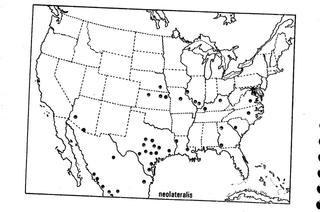
R. M. Bohart and L. S. Kimsey, 1982 · 9
Ipsiura neolateralis |
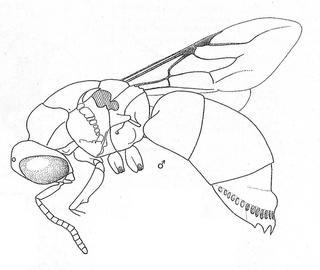
R. M. Bohart L. S. Kimsey, 1982 · 1
Ipsiura neolateralis |
|
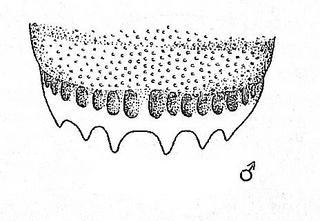
R. M. Bohart L. S. Kimsey, 1982 · 1
Ipsiura neolateralis, tail |
|
Overview | |
Neochrysis (Ipsiura) neolateralis Bohart
(Figs. 464, 471, 472)
Neochrysis neolateralis Bohart 1966:143. Holotype male, West Frankfort, Franklin County, Illinois (UCD).
Discussion: This is a large distinctive species in the subgenus Neochrysis. It can be distinguished from pilifrons by the well developed pit row preceded by a strong swelling and prominent basolateral white spot on T-III, forefemur with a subapical angle or tooth, F-I slightly less than twice as long as wide and black spots on S-II large and almost contiguous in both sexes, separated by a narrow line of green. The length range in this species is 7-10 mm, more than in pilifrons which is 5-7 mm long. N. neolateralis is found throughout southeastern United States and as far south as El Salvador.
Material examined: 27 males including type, 46 females.
Distribution: Texas, Arizona, Kansas, Virginia, South Carolina, North Carolina, Georgia, Louisiana, Missouri, District of Columbia, Illinois, Maryland, Nebraska; Mexico: Jalisco, Morelos, Sinaloa, Chihuahua, Nayarit, Veracruz; El Salvador. Collection dates are June through September.
Subgenus Ipsiura Linsenmaier
Chrysis (Ipsiura) Linsenmaier 1959:74. Generotype: Chrysis marginalis Brulle, 1846, original designation.
Diagnosis: T-III with four to six teeth, pit row distinct or represented by a well defined crease, lateral pronotal carina complete or nearly so, propodeum simple, frons with TFC and usually with at least traces of subcarinae extending back toward ocelli, mole than 20 recognizable described species but only two in America north of Mexico: neolateralis Bohart and pilifrons (Cameron).
Subgenus Neochrysis Linsenmaier
Pleurocera (Neochrysis) Linsenmaier 1959:74. Generotype: Chrysis punctatissima Spinola 1840 (nec Villers 1789 = carina Brulle 1846), original designation.
Diagnosis: T-III with four apical teeth and pit row nearly or entirely absent, no lateral pronotal carina, propodeum simple, frons without TFC, seven or eight described species but only two in America north of Mexico: arizonensis Kimsey and montezuma (Cameron).
Key to Neochrysis
1. Propodeum with basomedial projection (subgenus Exochrysis) ……………………………………………………………………..alabamensis (Mocsary)
Propodeum without basomedial projection ……………………………………………2
2. Pronotum without almost complete, well developed lateral carina; T-III pit row obsolete to completely lacking (fig. 469); frons without cross carina or subcarinae extending back to ocelli (fig. 467); T-III with four apical teeth (subgenus Neochrysis) ……………………………………………………………………………………………..3
Pronotum with practically complete, well developed lateral carina (fig. 464); T-III pit row well developed (fig. 471); frons with cross carina and/or with carinae extending back to ocelli; T-III with six apical teeth in nearctic species (subgenus Ipsiura) ………………4
3. F-I twice as long as broad or shorter; T-III with basolateral whitish spot; male F-I-III with erect white hairs, 1.0 MOD long or longer (fig. 467) …………...arizonensis Kimsey
F-I over twice as long as broad, usually 2.5 to 3.0 times; T-III without a basolateral whitish spot; male F-I-III without long white hairs ……………….montezuma (Cameron)
4. Forefemur with distinct angle or tooth beneath (fig. 464); T-III pit row preceded by a strong transverse swelling; pits large and elongate (fig. 464) …………neolateralis Bohart
Forefemur without distinct angle or tooth beneath; T-III pit row preceded by a gentle transverse swelling, pits small and nearly hidden in a creaselike pit row (fig. 470) ……..5
5. T-III with basolateral whitish spot ………………………………...genbergi (Dahlbom)
T-III without basolateral whitish spot ……………………………..pilifrons (Cameron)
|
|
| Supported by | |
Updated: 2024-04-28 03:41:16 gmt
|